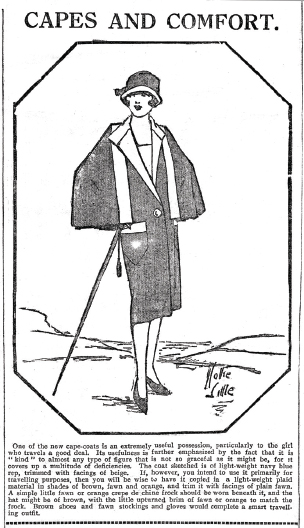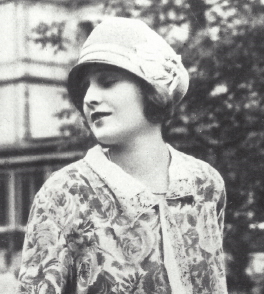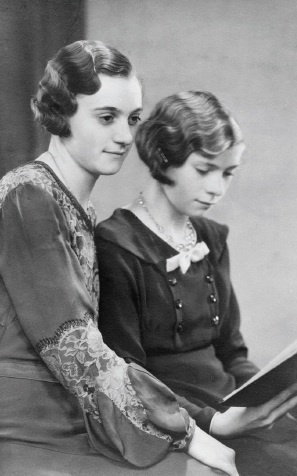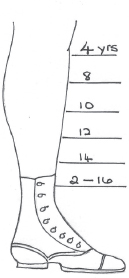
The Roaring Twenties
‘The present age is the first that has allowed a girl to be a decent percentage of herself …’
Nottingham Evening Post, Saturday, 2 October 1926
It seems unimaginable that women had to wait almost 2,000 years before they felt they could at last be themselves and not simply the clothes they had to wear. The war years of 1914–18 resulted in female liberation, though it was a shame it had taken a catastrophe of world-wide proportions for social blinkers to fall and for women to be recognised as useful and capable human beings. In 1926, in an address called ‘The Modern Woman’ delivered to the National Council of Women, the speaker, a Mrs Gresswell was delighted to confirm that women were finally realising their worth:
A girl nowadays is allowed to be about 80% herself. In the Victorian era she was allowed to be about 50% or less. This then is the first age wherein she has not been compelled – by law, custom, convention and so forth – to suppress one half of her true self. What she will be when 100% herself is delightful to anticipate.

Southend Pictorial Telegraph, 8 May 1926. (Author’s collection)
In hindsight such hopes appear poignant, especially as we now enjoy the benefits of significant changes, such as job equality and improved birth control, which see today’s modern woman possibly now about 99.9 per cent of her true self. Mrs Gresswell continued, ‘The girl today is ambitious, courageous and loyal … some retrograde people are dazzled by her, see her as a blurred specimen of humanity and wish she would be content to remain that incomprehensible, subtle thing of sex alone.’ She went on to warn, however, that new short hairstyles did not necessarily mean a woman was modern in mind. An Eton crop, she said, could cover a most un-progressive brain and the length of hair or frock had nothing to do with modernity, ‘It is the mind that dates us, not the things casually wrapped around it.’ In her opinion, just as there were women who did not resort to cosmetics and cocktails and who were wholly modern in mind, there were equally those whose dress, freedom and abounding health were of the age but whose minds were decidedly blank concerning the larger welfare of their sex:
The old fashioned flapper … is always recognisable in that she has little or no sex-pride. She may have pride of self, but she has no pride in her womanhood, no belief in its importance, claiming from men not the respect due to an equal but the good natured tolerance one accords to a child. Old fashioned flappers are a small minority daily becoming smaller. The average girl has got rid of this unnatural inferiority complex. Most girls today take the keenest interest in their citizenship and fiercely resent the inequalities which are maintained between the sexes.
For the women attending that address it must have seemed that the days ahead would be unhindered. Probably they had never heard themselves so ‘talked-up’. Yet, these new lives they were living in the ‘roaring twenties’ symbolised by the short skirt, bobbed hair and close-fitting cloche hat did not escape scrutiny nor stereotypical remarks and were examples of just how far women still had to go. The Times of 1923 commented that the cloche continues because it is the only shape that fits short hair: ‘In youth eccentric hairdressing may pass muster but after forty no woman should change the style of her hair’.
The Cloche … a Statement of Understated Chic
The cloche hat was invented by the Parisian milliner and French fashion designer Caroline Reboux in 1908, and it wasn’t long before this small, unassuming fashion accessory, along with the dropped-waist dress, became one of the most recognisable shapes of the 1920s. Due to its deep and fitted shape it was given the name ‘cloche’ (a French translation of the English word ‘bell’) and soon hairstyles were being created around it. The hat became especially popular during the 1920s, and continued to be commonly seen until about 1933. As with many fashions before and since, it did not please everyone. On Saturday, 8 August 1925 the Bath Chronicle and Weekly Gazette ran the following warning, citing the modest cloche hat as the latest danger to womankind from articles of clothing:
The new danger in a woman’s attire had been pointed out by the Nottingham city coroner at an inquest on a young girl knocked down by a motor-bus travelling at four or five miles an hour. ‘The hats worn by women these days are as bad as blinkers on a horse’, he said. ‘Women are completely blinded on one side of their faces. I wonder they do not meet with more fatal accidents.’

A cloche hat. (Author’s collection)
A woman’s hair was thought to be her crowning glory and to cut it caused condemnation from almost all walks of life. Edwards’ ‘Harlene for the Hair’ advertising was aggressive, using testimonials from royalty and stars of the Victorian music hall. It claimed that Harlene restored the hair, lengthened it, gave it ‘body’ and encouraged growth in babies! (Author’s collection)
The coroner was referring to the latest cloche hats – tight at the neck and fairly wide-brimmed at the front, and popular owing to the smart way they fitted shingled heads.
The effect was to make it impossible for any wearer by a mere turn of the head to see traffic more than 10yd away approaching them at right angles. The tightly fitting brims round the ears deadened the warning sounds of traffic. Later, models were made with the front brims turned up and the ears left free from tight coverings (as reported by the Daily News).
For the cloche hat to fit and be a success hair needed to be close to the head, preferably slicked down and, of course, short. The subject of short hair was however a bone of contention between those in favour and those against. It seemed there was no limit to the arguments.
In 1923 the Salvation Army was drawn into the debate when reports from America caused considerable interest in England, due to a young Army captain, Mildred Olson, having been called before her superior officer for cutting her hair short. Representatives in London were asked for their opinions on the matter and though their answers varied they all agreed she should not have done it. One lady officer said that for her part she did not like to see bobbed hair and when her girls had asked her opinion on short hair she had always advised against it. A male captain when questioned admitted that in many cases it might improve the appearance but he would not advise any Salvation Army girl to be so frivolous as to cut her hair short. Another officer added that ‘the glory of a woman is her hair and to cut it off is to desecrate it’. Neither did bobbed hair sit well with the Nottingham Board of Guardians with regard to the female nurses at their Bagshot Institution. There, in 1925, they were called to explain themselves over allegations that where female staff had already ‘bobbed’ their hair they had been ordered to grow it back again!
As early as 1922 there were influential figures speaking out against the modern practice of a woman ‘bobbing’ her hair. A keen evangelist preacher in Aberdeen, the Revd Nicholson, advised an audience of boys in Belfast that they should never marry a girl with bobbed hair, his reason being that the glory of women was in their hair and the Devil liked her to get it cut off. A fair comment for a man of the cloth who appeared to uphold the scriptures where it states that when a man’s hair is long it is his shame but for a woman it is her crowning glory. Unfortunately, he then spoiled it by stating that the only way a woman ought to maintain her nails was on the washboard – possibly a sexist step too far.
A Scottish hairdresser, also of the same mind, placed a statement in the Tamworth Herald which read: ‘For conscientious reasons, based on the teaching of the Holy Scripture, I have decided to discontinue all ladies hairdressing forthwith and I wish this announcement to save as far as possible those concerned from any inconvenience that may be caused thereby.’ As a member of a strict religious body, he obviously held extreme views on the bobbing of women’s hair.
Almost universally men, it seemed, did not embrace the new-fangled short styles, with one young man unprepared to compromise. Prompted to take matters into his own hands, though perhaps not face to face, he wrote a note explaining his point of view:
Dear Ivy
I am sorry to write these lines, but I think it best that our friendship should cease altogether and more so now, seeing you have put the lid entirely on, as you have had your hair bobbed. I cannot see that it suits you and also I am against it altogether. You never told me you were going to have it bobbed so take it for granted that we have finished for good.
Walter.
He was obviously not alone, with husbands and boyfriends not afraid to go to great lengths to show their displeasure. The actions of one French gentleman were certainly a warning to all wives who neglected to consult their husbands before visiting the hairdresser. After his wife, Madame Chaplin, had left the marital home because, she alleged, her husband had insulted her after she had had her hair bobbed, Mr Chaplin obtained a deed of separation for desertion. The wife brought in a counter suit but judgement was given against her on the grounds that ‘however insulting the epithets used by her husband might have been they were justified by the fact that the wife had her hair shingled (named after the method for tiling roofs which allows tiles to overlap each other) without her husband’s permission’. Strong stuff over something as simple as a haircut, but nowhere as dangerous as an incident in Lisbon. Here because a man’s daughter had had her hair cut with her mother’s consent he decided to murder them! The suicide of a Charles Serlandier was also blamed on the cutting of a woman’s hair when he carried out his threat to shoot himself through the heart if his daughters followed the fashion. The ‘bob’ was even blamed for the death of a lady of 82 who had had her hair cut and was found dead after complaining of the cold.

Mother and daughter with Marcel waved hair, 1920s/1930s. The style was liberating for women but not universally favoured by men. (Author’s collection)
The knock-on effect of a woman’s new-found freedom to cut her hair was also economic, both abroad and at home. Bobbed hair was blamed for unemployment in China where the industry involved in making hair nets was suffering, while hair-pin manufacture also witnessed a slump. London brush-makers claimed that bobbing and shingling the hair had significantly reduced the demand for hair brushes, with one claiming that he had been able to sell dozens in his twenty-two years in the trade but now he was hard-pressed to sell even one. ‘Nowadays ladies only need a small pocket comb’, he mourned.
Scare stories abounded aimed at changing the minds of those about to follow the new fashion, with statistics released claiming that bobbing, shingling and clipping were causing more premature grey hair among women under 30 than there had ever been before. Hairdressers, disregarding their own profits, even warned their clients that shingling usually meant grey hair in a year, one commenting:
Britain is being turned into a nation of grey-haired young women … women come to me with faces totally unsuited to shingling and ask me to cut their hair for them. I beg them not to but they want me to go ahead. One woman of about 45 with a beautiful classical head insisted on having her head bobbed last week. When she saw the result she burst into tears.
On the whole it did not deter those eager to go ahead and hairdressers could not help but prosper, with no unemployment and London’s hairdressers in particular enjoying a period of unparalleled prosperity. A skilful hairdresser earned anything up to £12 a week, with weekly wages, including tips to girl assistants, averaging about £7 in the West End. For the first time in history, a woman having her hair cut in this manner always needed to look well groomed and so frequent visits to her hairdresser were paramount, but in no way an inconvenience. ‘Bobbed hair is a state of mind and not merely a new manner of dressing my head’ was the statement of one woman interviewed in the Pictorial Review of 1927. When she added, ‘to my way of thinking, long hair belongs to the age of general feminine helplessness. Bobbed hair belongs to the age of freedom, frankness, and progressiveness’, she unwittingly echoed the thoughts in most of the bobbed heads in the country.
The problem of cropped hair did, however, remain a sticking point with the threat of the shingle style even reaching the upper tiers of society and debated in relation to the ‘coming-out’ of many young debutants who would be taking part in the ceremonies to be held in May and June. As in other years, in 1927 the Lord Chamberlain was to set the rules on how long a train should be, the length of sleeves, etc. and it was rumoured that this year he would be asked by the King to discourage cropped and shingled hair. It was well known that the King had conservative views on the subject of hairdressing, which were shared by most of the female members of the royal family, but he had never sought to impose his views on society in general. It was rumoured that the Duchess of York was contemplating a ‘shingle’, and someone else had remarked that while Mrs Winston Churchill and other ladies had cut their hair, Mrs Baldwin, and Lady Chamberlain would never sacrifice their tresses.

Josephine Baker popularised the severe Eton crop hairstyle, which did not suit everybody. (Author’s collection)
‘Flapper-girl’ designs from the Ladies’ Home Journal, 1928, claiming to be ‘chic in their simplicity’. (Author’s collection)
If short hair in general was a problem then the particularly short Eton crop style was a catastrophe. Intended to be the ultimate symbol of female liberation, it was modelled on a masculine hairstyle, copying a slicked down appearance with long kiss curls in front of the ears to resemble sideburns. Popularised by Hollywood star Josephine Baker, it was extreme to say the least with Baker’s image used to promote a hair pomade called Bakerfix, created by her and which made the style perfect for the cloche hat. Newspapers loved to hate it with headlines such as ‘How much longer will the women of England allow their beauty to be mutilated by the Eton Crop?’ and ‘Hideous Eton Crop – fashion that suits no woman’ backed up by Bond Street stylists who damned it as ‘ugly’ and ‘Manish’. Some elements of the media tried to promote a balanced view, one featuring a letter from an employer of numerous girl clerks and typists who said he was pleased with the Eton crop as it made ‘the office look neater’ and gave the place a more business-like appearance. To trivialise the whole matter it was then dismissed as a summer fancy and would wane in the winter when women, feeling cold, would be only too pleased to grow back their hair.
The Shock of the New
It is fair to say that when ladies’ skirts rose after the First World War gentlemen were at a loss as to where to look, so unused were they to seeing – for the first time in public – a woman’s ankle. By the 1920s, with cropped hair and the lean boyish silhouette in the form of drop-waisted dresses which flattened the breasts and made no distinction between waist and hips, men had become quite confused. To say that the straight lines of the modern woman’s dress were disliked was an understatement, after all for centuries gentlemen had found beauty in a woman’s curves, and to have all a woman’s charms de-sexualised at once was most disconcerting. The advent of the shorter skirt went some way to redressing the balance but also left many a male embarrassed and unable to believe his eyes.
In 1928 the writer, George Bernard Shaw addressed a public meeting at the King’s Theatre, Hammersmith where he, over the course of the evening, expressed many interesting observations made over his lifetime, including the fact that as a man living and working for the most part during the Victorian period he had at an early age formed the opinion that in the matter of dress women were far more ‘upholstered’ than ‘dressed’:
The Victorian age succeeded in one of the most amazing and grotesque enterprises ever tried by mankind. The thought that woman was a human being was intolerable to them. They set up a convention that women were angels. It’s all very well being an angel up to a certain point: but there comes a time when you are impressed by the fact that you are not an angel but a human being with a human being’s needs. When crinolines were beginning to drop out a lady who was always in advance of her age, suddenly appeared at our house and disclosed what to me was the amazing fact that … women had legs.
Glad the past had faded and the world was embracing new and exciting ideas, he finally declared, ‘I can stand any amount of ladies with short skirts nowadays’.
Medical opinion was in full support of the short skirt, advocating the health benefits of no longer having to wear ground-sweeping garments which gathered mud and germs and were a symbol of the sham and gentility of the Victorian era. The short skirt had not only changed the appearance of the wearer but put women on an equal footing with their brothers and introduced them to the advantages of recreation. No longer tied simply to reading books, now they could play tennis, hockey and golf. They could go swimming, dancing and walking and do themselves more physical good in a year than their grandmothers had done in a lifetime. A new found badge of freedom, the short skirt put an end to voluminous clothing and a woman’s inability to ‘indulge herself in the healing properties of sun and air’.
School medical officers had nothing but praise for the short skirt, reminding those against it how in the past female fashions had sapped a girl’s strength and that now female health had greatly improved with the passing of the corset and garters. Even Harley Street doctors praised both short skirts and short hair saying they were two of the greatest boons to modern womanhood. Supposedly, one advantage of short hair was that it reduced headaches and it was advocated that if a woman cut both the length of her skirt and lightened the weight of her lingerie by half, and went out in the cold wearing only two layers of clothing, she would extend her life by at least five years! It was the popular belief that, in short, the short skirt was here to stay.
On the contrary, Paris dress designers were up in arms in 1929 with fashion experts declaring that women’s hems must once again descend as ‘since the short skirt came into being there has been no “chic” among women’. They pointed out that the skirt had been around for fifteen years now and was a creation of the war years, not a product of France but of the Americans. The French wanted to make women ‘charming’ again. ‘What can one do with it?’ French fashion houses decried. ‘The short skirt is the uniform of the giddy flapper and we have had enough of it. We want women’s fashions to be the fashions of the few. It is impossible to differentiate between women of different rank if they wear short skirts.’ This was a clear indication that for some the pre-war class system was not quite dead. ‘Dressmaking has taken a battering with the low level the short skirt had reduced it to. People are losing their taste for beautiful fabrics.’ Short skirts, however, held out against their critics.
Amendralejo, a town in western Spain, proposed to introduce a tax on women whose dress reached less than a certain minimum length. To ensure the proper observance of the regulations, a tax inspector, provided with a yard measure, was employed to patrol the town and stop every woman whose skirt, according to his view, was not proportionate to the official measurements and if found not to comply the woman was to receive a court prosecution and fixed fee. If she wished she could buy a licence which would enable her to wear the offending skirt and if she renewed it on a monthly basis she could continue to do so. Mill girls in Italy were also threatened with dismissal for having skirts too short as part of an anti-indecent dress crusade, and men urged to end all friendships with women friends whose clothes ‘offended their susceptibilities’. In one northern Italian town youths took things into their own hands and seized girls whose knees could be seen, marking with heavy crayon the point on their stockings where it was thought seemly that their skirts should end.

For over two centuries a young girl’s skirt length was related to her age. (Author’s collection)
Strangely enough there had always been an unwritten rule as to the length of a girl’s skirt as she grew up but with the advent of the short skirt that seemed forgotten, and replaced with the theory that if you measured your ankle and then subtracted that number from twenty your skirt length would best complement your height and shape. Thus if your ankle was 8in, and subtracted from 20in this would leave 12in, the optimum length of your skirt from the floor. Another theory was that instead of the seven ages of man there should be the seven ages of the skirt, with girls in their teens allowed to wear the ultra-short skirt coming just below the knee, with a few inches to be added for each ten years. There would then be a perfect gauge from the ages of 17 to 70.
By November 1926 short skirts were thought a problem in the winter months and a Regent Street firm of shoemakers invented a stocking guard to save silk stockings from being mud-spattered. These were translucent rubber that according to the adverts were ‘practically unnoticeable when worn’. They could be slipped on and off in an instant and afforded absolute protection from ankle to knee. Their transparency in no way detracted from the beauty of silk stockings. They were certainly popular as 10,000 pairs were sold by the firm in the first week.
Controversy followed the short skirt (and the girl who was wearing it) wherever it was seen, but for some establishments it was the perfect opportunity to tell the world, or at least the locals, that they were modern and forward thinking as opposed to others who definitely were not. In 1928 Dundee tram officials wanted it known that they had no intention of asking their employees to copy the actions of a neighbouring Sheffield tram conductor when he asked a 20-year-old girl whose short skirt offended two elderly women to leave the tram. They wished it known they were not about to embark upon a puritanical campaign against the abrieviated skirt. On the contrary, it was suggested that perhaps if a girl in a short skirt was employed to sit in the tram on a daily basis then ticket sales would no doubt take a turn for the better.
Sheffield Tram Co., on the other hand, had empowered its conductors to evict from their trams anyone thought to be dressed offensively, and this had been carried out in the case of a chimney sweep who had got on the tram when in full working clothes. He had been thought to be causing offence and so was asked to leave. The Dundee Tram Co. wished it known that the thought of a girl in a short skirt hardly constituted ‘offensive’ and announced it in the papers. They ended by saying that they did not consider itself a trustee for public morals and therefore would not be throwing any short-skirted ladies off their vehicles, any time soon.
In an attempt to reintroduce long skirts lobbyists tried long and hard to turn the tide but to no avail, even when it was suggested that men can have ‘enough of knees no matter how nice the stockings’.
